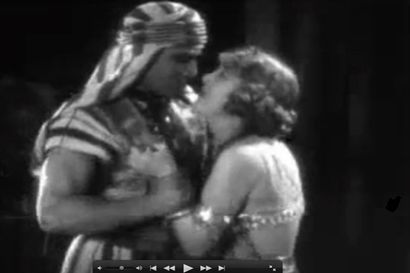
Western Cinema has always been fascinated by sexed-up imagery of Arabian knights, Persian queens, and shirtless warriors. The earliest films stereotyped the Middle East as a region of greedy men, camels, deserts, arbitrary cruelty, and barbarism. While modern cinema can--at times--present a more nuanced and balanced view, stereotypes persist. But as ticket sales prove, a sexy desert hero can mean big bucks at the box office.
Indiana Jones: Raiders of the Lost Ark
Steven Spielberg's wildly successful series proved "Indiana Jones" to be king of the box office, if not also the desert. In the 1981 film, Jones, as played by an open-shirted Harrison Ford, is tasked with finding the Ark of the Covenant in Cairo and confronts his enemy, the Nazis, in colorful bazaars.
Princess Ali, Egyptian Dance
In the 12-second silent film, Princess Ali from 1895, a dancer with the Barnum & Bailey Circus, performs an oriental belly dance. Originally recorded by a Kinetoscope in the Edison Manufacturing Company's Black Maria film studio, the movie became popular because of the general public's fascination with exotic dancers. As a result, a succession of similar silent films was released in the late 19th century.
Cleopatra
The ancient Egyptian queen Cleopatra VII, played by a vivacious Elizabeth Taylor, mesmerized audiences to make this the highest-grossing film of 1963. The on-screen chemistry between Taylor and her costar Richard Burton, who played Marc Antony, continued off-screen.
Intolerance
This silent black-and-white film involves a prince from ancient Babylon, a Persian king, and more than 3,000 extras. Considered a masterpiece in film circles, it was D. W. Griffith's follow-up to his controversial and racially charged The Birth of a Nation. The director tells four different stories using avant-garde editing techniques, one of which focuses on the conflict that arises between believers of different Babylonian gods that ultimately leads to the city's downfall.
Lawrence of Arabia
This classic, $15 million blockbuster was filmed in Jordan, Morocco, Spain, and the United Kingdom, and was based on the life of British army officer T. E. Lawrence. Starring a young, bright-eyed Peter O'Toole, Lawrence leads a military revolt only to be torn between his allegiance to Britain and the Arabian desert comrades he has befriended.
Sex and the City 2
The four girlfriends—Manhattan royalty in their own right—take a fabulous vaca in the Middle East when a chic Arab sheik asks Samantha to plan his public-relations campaign. With numerous references to magic carpets, Scheherazade, and Aladdin, an over-the-top Samantha transplants sex from the city to Abu Dhabi.
The Son of the Sheik
Heartthrob Rudolph Valentino stars as hot-blooded Ahmed, the son of an Algerian leader who falls in love with a street dancer, Yasmin, in this sequel to The Sheik. Ahmed kidnaps Yasmin twice in the film, only to be chased through the desert.
Mickey in Arabia
In this animated seven-minute feature, Mickey and Minnie Mouse visit the Middle East when Sultan Pegleg Pete kidnaps Minnie to work for his harem. Not quite a hunk, scrappy Mickey has been idealized as the perfect mate for Minnie by generations of Americans.
Prince of Persia: The Sands of Time
Inspired by the eponymous videogame, the movie stars a CGI-buffed Jake Gyllenhaal as the adopted prince of ancient Persia. Gyllenhaal aligns himself with an exotic and feisty princess to prevent a villainous nobleman from possessing the Sands of Time, a gift from the gods that can reverse time and allow its owner to rule the world.
The Thief of Bagdad
From the collection of stories One Thousand and One Nights, Prince Ahmad is blinded and cast out as a beggar. Ahmad, the true king of Baghdad, falls captive to Jaffar, who places him in a dungeon, where he meets Abu, an expert thief. They escape and embark on a fantastical journey that involves a genie in a bottle, a mechanical flying horse, a flying carpet, and a beautiful princess.
Aladdin
This Disney classic was hailed as one of the best animated features of the century and earned more than $504 million worldwide. The American-Arab Anti-Discrimination Committee took issue with this film in 1995 and said it was racist. The committee pointed out that Aladdin and Jasmine are light-skinned while all other characters are "dark-skinned, swarthy, and villainous-cruel palace guards or greedy merchants with Arabic accents and grotesque facial features."
Kismet
Set in ancient Baghdad, this musical involves caliphs, beggar-poets, princesses, and princes. Nearly everyone in the film was white and painted a darker color to signify an Arab heritage.
Three Kings
Set after the end of the Gulf War, three American soldiers go off into the Iraqi desert to find millions in stolen Kuwaiti gold that they in turn hope to steal. Instead, the "kings," played by a kind of Hollywood royalty in George Clooney, Mark Wahlberg, and Ice Cube, become involved in a democratic uprising.
300
Set in 480 B.C., 300 tells the story of as many Spartan soldiers fighting off the invasion of Persian king Xerxes' army of 100,000. Brazilian actor Rodrigo Santoro stars as the egotistical but toned King Xerxes of Persia. Rich, gold-skinned, and covered in gold jewelry, this antagonist helped the movie score more gold at the box office.
Uncommon Knowledge
Newsweek is committed to challenging conventional wisdom and finding connections in the search for common ground.
Newsweek is committed to challenging conventional wisdom and finding connections in the search for common ground.
About the writer
To read how Newsweek uses AI as a newsroom tool, Click here.








